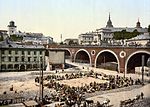The Royal Castle in Warsaw (Polish: Zamek Królewski w Warszawie) is a royal residence that formerly served throughout the centuries as the official home of Polish monarchs. It is situated in Castle Square, at the entrance to the Warsaw Old Town. The personal offices of the king and the administrative offices of the royal court were located in the Castle from the 16th century until the final partition of Poland in 1795.
Initially, the fortified complex served as the residence of the Masovian dukes. In the early 1600s, it was designated to replace Wawel Castle in Kraków as the seat of the King, Parliament (Chamber of Deputies and Senate), and the Polish–Lithuanian Commonwealth. The medieval Gothic structure was remodelled into Italian mannerism by architects Matteo Castelli and Giovanni Battista Trevano. The Baroque easternmost wing was designed by Gaetano Chiaveri and completed in 1747.
The Royal Castle witnessed many notable events in Poland's history; the Constitution of 3 May 1791, first of its type in Europe and the world's second-oldest codified national constitution, was drafted here by the Four-Year Parliament. The edifice was redesigned into a neoclassical style following the partitions of Poland. Under the Second Polish Republic (1918–1939), it was the seat of the Polish head of state and president.
The Second World War brought complete destruction to the building; in September 1939 it was targeted and ignited by Luftwaffe fighter aircraft, and then detonated by the Nazis after the failed Warsaw Uprising in 1944. In 1965, the surviving wall fragments, cellars, the adjacent Copper-Roof Palace and the Kubicki Arcades were registered as historical monuments. Reconstruction was carried out in the years 1971–1984, during which it regained its original 17th century appearance. In 1980, the Royal Castle and surrounding Old Town became a UNESCO World Heritage Site. Today, it serves as a museum annually visited by over 500,000 people, and one of Warsaw's most recognizable landmarks.












